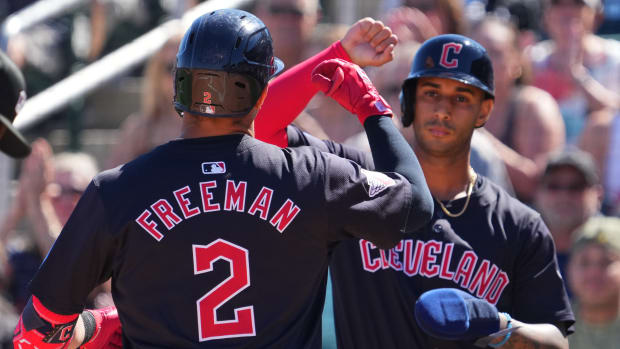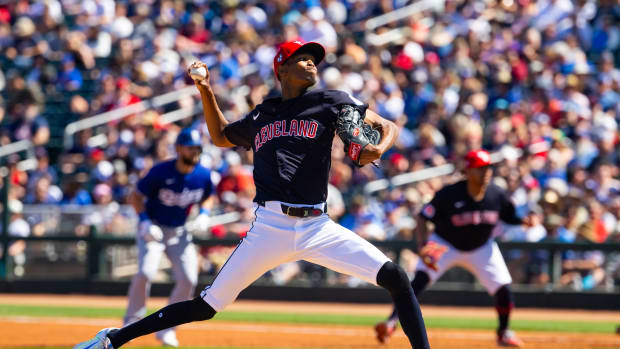Breaking Down the First Run Through the Cleveland Indians’ Rotation
With just 60 games to work with this season, the Cleveland Indians’ chances of contending are going to live and die by the rotation. While a few formidable hitters are littered throughout their lineup, the starting pitching is what gives them the best chance to hang with the reigning division champion Twins.
Said chance may have improved a bit after the first run through the Indians’ rotation. In fact, if the numbers produced by Cleveland’s starters can be maintained, it’s not just Minnesota who needs to be concerned.
To be blunt -- what we’ve seen so far from the Indians’ rotation isn’t just impressive, it’s absurd.
Let’s start with the surface-level numbers.
In 39.0 innings pitched, Shane Bieber, Mike Clevinger, Carlos Carrasco, Aaron Civale, Adam Plutko and Zach Plesac have combined for a 4-0 record, boasting an ERA of 1.85. It’s the best record of any rotation, with an ERA second only to the Texas Rangers (0.39).
In all honesty, you can make an argument these are the least noteworthy stats we’ve seen from the starters so far.
Cleveland’s rotation is currently in the top five of the league when it comes to FIP (2.27), strikeout rate (36.5%), K/9 (12.46), opponent batting average (.194), ERA- (40) and FIP- (56). It leads the league in WHIP (0.79) and has the lowest walk rate (2.0%) and BB/9 (0.69) in the majors.
To further hammer home how infrequently Indians starters are dealing free passes, they’re currently averaging a strikeout-per-walk-rate of 18.00, tops in the majors. The Cincinnati Reds own the next best average at 6.38.
For what it’s worth, FanGraphs isn’t seeing much deception in the numbers Cleveland’s starting pitching is putting up.
Using the outlet’s Skill Interactive ERA metric (SIERA) -- which determines what a rotation’s ERA should be by comparing it to rotations with similar strikeout rates, walk rates and ground ball percentage -- it estimates an earned run average of 2.10 for the Indians’ rotation. That’s only 0.25 points higher than its current ERA.
In sticking with the theme, said SIERA is second only to Cincinnati (1.96).
Keep in mind, the performance we’ve seen so far is occurring one season after Cleveland traded both Corey Kluber and Trevor Bauer. Yet, despite losing two marquee members of the rotation, the unit looks stronger than ever.
Bieber followed a shaky opening frame against Kansas City -- during which he beaned a batter before issuing a walk and a hit -- by striking out 14.
Clevinger -- whose 24.0% strikeout rate after one start ranks as fifth-best among the rotation -- gave up two solo shots Saturday evening, yet still left the game with a WHIP of 0.57.
Making his first start since being diagnosed with leukemia, Carrasco spun a six-inning gem Sunday afternoon. His changeup -- which gave him trouble last season -- looked significantly more effective, as he allowed no hits and just two batted balls off this pitch.
If Civale is out to prove his 2019 debut was no fluke, his first start of the season certainly helped his cause. The 25-year-old had Chicago hitters chasing his wide array of pitches throughout Tuesday’s contest, as he generated whiff rates of 40% or higher on both his cutter and curve. Only one of his pitches from the game produced an average launch angle above zero.
Plesac, whose Expected Outcome stats hinted his 2019 season may have been deceiving, erased some of that doubt last night. He set a new career high with eleven strikeouts against Chicago, thanks to increased usage of a slider which generated a whiff rate of 59.1%.
Even Plutko, who stepped to the mound in a spot start Tuesday night, ensured the rotation kept its momentum going. In six innings of work, he maintained a WHIP of just 0.83 while notching four strikeouts and allowing just two earned runs.
All in all, when an appearance like that represents the “least impressive” of Cleveland’s starting five, you’re in a good spot.
Sure, it’s too early for any definitive takes about Cleveland’s rotation, outside the fact none of the starters had much rust to chip off. Still, this doesn’t make the numbers any less astonishing.
Simply put, if this is the kind of production the Indians can expect to receive from their starting five, they may be a far more fearsome opponent than many anticipated this summer.




